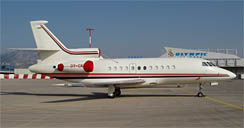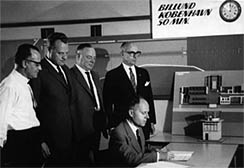The Airport

The Lego airplane hangar, 1961
By the 1960’s Lego was sold in almost all of Western Europe, North America, Australia, Singapore and Japan. As the interests of the company began to be spread around the globe Godtfred decided that he needed an airplane for long-distance travel. He, in partnership with a neighboring company, Danfoss, bought a small 4-seater prop plane. Initially the plane used the Vandel air-strip and later the Esjberg airport.
In 1961, in partnership with Sonderjyllands Flyselskab (later to become Climber Air), Lego’s chief pilot, Hans Eric Christiansen, took delivery
of a larger aircraft, a Piper Apache, and Godtfred built his own ‘airport’: a wood hangar and an 800 meter grass airfield directly north of
the factory in Billund.1
1. Lego AS and Kirkbi AS owned a corporate aircraft from 1961―2004. Their last jet, a French Dassault Falcon 900B,
was sold off as part of the 2004 financial restructuring.

The Billund Airport Cooperative Society
Godtfred offered his airfield to the neighboring communities of Billund, Fredericia and Kolding if they agreed to upgrade the strip to a public airport. The Billund Airport Cooperative Society was formed with A.M. Wamberg, the governor of Vejle amt, as chairman. A joint commercial venture between several municipalities was a new idea to the local politicians and talks were not successful until Godtfred offered to financially guarantee the project for the first five years. Construction began in 1964 and the new airport, the Billund Lufthaven, was officially inaugurated on 1 November 1964 with SAS (Scandinavian Air Lines) offering twice daily service between Billund and Kastrup. H.E. Christiansen became the airport Director, a title he held until his retirement in 1996.

Various photos presenting important moments in the history of the Billund Airport
Initially the airport consisted of a 1660 meter runway, an apron, control tower and the existing Lego hangar. A new passenger terminal was completed in 1966. The runway was lengthened several times and by 1971 reached its current length of 3100 meters. Maersk Air began international flights in 1985 and a new passenger terminal was inaugurated on 30 May 2002. Today the Billund Airport (BLL or EKBI) is the second busiest airport in Denmark, behind only the Copenhagen Airport (CPH/EKCH).
Dagny Holm
Dagny, who was Godtfred’s cousin, was classically trained as a sculptor and joined the model shop in the early 1960’s.2 2. The model shop was not her first involvement with Lego. In 1935 Dagny designed a set of wooden children’s coat hangers for Ole. It took her some time to fully grasp the artistic possibilities of the brick but when she finally did everything became a subject for Lego:
3. Weincek, Henry, The World of Lego Toys. New York: Harry N. Abrams, 1987. “I saw everything in these bricks. Even on a train in Copenhagen I would be looking at people and calculating how many bricks for that nose, how many for that face.” 3
At the time the model shop mostly constructed models shown in various catalogs or idea books but Dagny began creating large-scale models that completely changed how Lego looked at the models. Her designs were realistic but also showed a unique sense of humor. A philosophy that has become the standard for the model shop. Soon Dagny became the chief model designer.
These models became the companys’ most important promotional tool and captured the imagination of children as well as adults. They were used as point of sale displays, shown in traveling exhibitions and even became the basis of a theme park. Dagny continued to oversee the model shop until her retirement in 1986.
1964 World’s Fair


The Danish Pavilion, 1964 World’s Fair
The was perhaps no better example of the internationalization of Lego, or its importance in Denmark, than the 1964 New York World’s Fair. The Danish pavilion was designed primarily as a playground for children (modelled after Tivoli Gardens) and an exhibit promenade. As the Official 1965 Guide book stated “Children can romp in a novel playground while parents sample fine Danish products in shops, restaurants and a sidewalk cafe.” Naturally Lego was featured in the playground and boutique. They even offered two special promotional sets imported from Billund.
The Instruction book

The blueprint intructions, 1964

Instructions from set 317, 1968
The idea of building instructions was, initially, simply an afterthought. The first instructions, from the mid 1950’s, were simple elevation plans, typically printed on the inside box lid. It was hardly enough information to even build the model.
Futura and the Graphics department revisited the idea in the 1960’s as the sets became larger and more model-like, and in 1964 they produced the first of the modern instructions. The new format consisted of elements laid out in a 30° isometric view. Starting with a few elements as the base, parts were added in a step-wise fashion. By comparing one step to the next children could see what elements were to be added and where they were to be placed and the model would appear to grow. The new format was so concise that written directions were unnecessary and could be used by children in any country. It was a major breakthrough for the company. Over time this format has been imitated by virtually every construction toy manufacturer.
The Basic Sets
In 1964 Lego released the first of a new series of basic sets. These sets were larger, reflecting the new scale of the system, and packaged in an updated box design. The 040 and 050 sets were released in 1964 and were followed by four additional sets the next year. It marked the end of the venerable 700/x series, which had been introduced 15 years earlier.
The new basic sets were followed two years later with a new, updated series of supplementary sets. The new supplementary box design was the first to show the contents on the box front.









